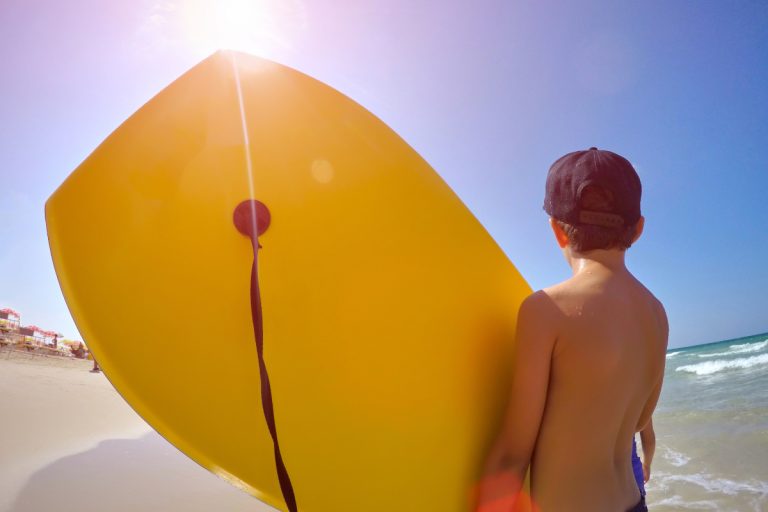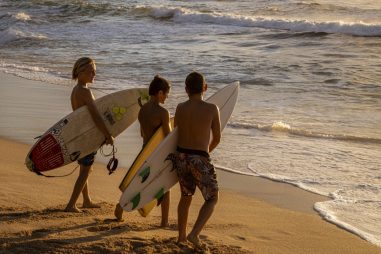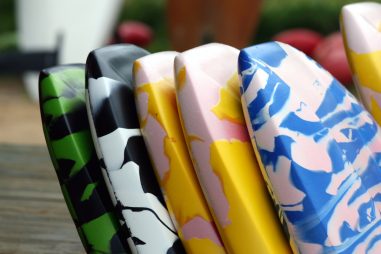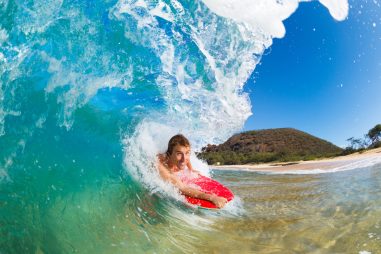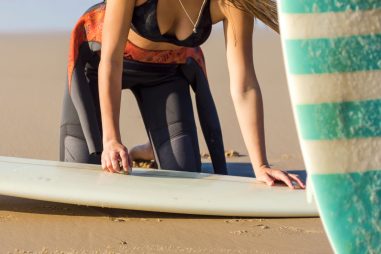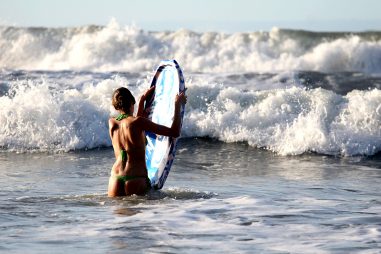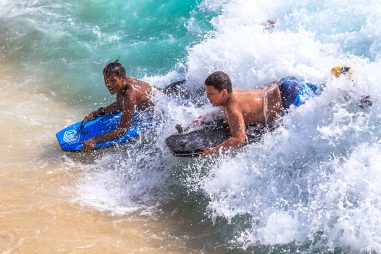It’s easy to learn, allowing the surfer to ride the waves without standing up. With proper gear, you’ll find that boogie boarding is safe for kids and adults. It’s a fun way of enjoying the waves, making it a favorite recreational activity for families!
What Do You Do With a Boogie Board?
To use a boogie board, you will need to lie flat with your belly on the board. You may also use swimming fins to help you propel forward. For beginners, it is best to start with a small-scale wave near the beach. To learn how to use a boogie board, follow the directions below.
Steps to Use a Boogie Board:
- Wear a rash guard or wetsuit to avoid sunburn and rashes.
- Wear the leash on your wrist, and make sure it’s attached to the board.
- Wear your swim fins if you are using one. Wear them near the shore so you won’t trip in the sand.
- Go to the water until knee-deep.
- Place your board in front of you, with your hands holding on to the rails.
- Lie flat with your belly in contact with the middle part of the board. Your hips are on the tail of the board.
- Using your arms, paddle towards a crest. Support your arms by kicking your feet.
- Turn towards the shore as the wave starts to break, with your back facing the ocean.
- Place your elbows on the board for better control.
- Kick your feet and let the waves drag you smoothly back to the shore.
A boogie board is much shorter than a surfboard. It varies in size and is dependent on the rider’s preference and needs. Ensure that you select an option suited to your height and weight. Apply a small amount of wax on the nose, tail, and rails of the board like you would on a surfboard to improve your grip while riding.
What Age Group Are Boogie Boards for?
There is no specific age group for boogie boarding. However, kids as early as 3 to 4 years old can learn the sport if provided with guidance. Adults and the elderly may also enjoy the sport as recreation, serious sport, or even therapy. Boogie boarding can be for everyone, making it an exciting activity for all.
No matter your age, it’s recommended that you never ride in the water alone. If you are with children, do not let them go to the water unsupervised. It’s always a good idea to have someone with you in case of an emergency.
Is Boogie Boarding a Sport?
Boogie boarding is one of the most popular water sports around the world. It was first considered a casual sport in Hawaii. Eventually, it led to its first championship competition in California. Boogie boarding then became a global phenomenon. Tournaments continued with champions hailed all over the world.
Although it was an unwelcomed sport decades ago, boogie boarding’s popularity heightened because of new and original moves introduced by professional boogie boarders. As a result, it is now considered a sport in its own right.
Is Boogie Boarding Fun?
It is not a secret that kids and adults love boogie boarding because it’s fun! You can learn boogie boarding within an hour, making it an easy sport to learn. It’s also a more relaxing way of experiencing the energy of the waves. Plus, it’s affordable and easier to buy. You can go to Walmart or Costco and get a good-quality board there.
Another great thing about boogie boarding is its flexibility in the weather. You won’t need to wait for the surfing season to enjoy the sport. It also doesn’t require a specific beach. You can have fun boogie boarding in either big or small waves.
Is Boogie Boarding Easy or Hard?
It’s not required to have complex skills to learn boogie boarding. Unlike surfing, it is less challenging and allows anyone to learn to ride the waves with ease.
When maneuvering, it is as simple as leaning on your left to turn left; and right to turn right. While ensuring that you apply pressure on the board with your elbow while gripping tightly.
With practice, you can perform creative tricks popular with boogie boarders. Doing this will add a little bit of a challenge and give you a more thrilling experience. In addition, it will add style and uniqueness that is comparable to surfing.
Is Boogie Boarding Safe or Dangerous?
Boogie boarding is generally safe, but it doesn’t mean it doesn’t have its safety precautions. First, it’s paramount that you have the correct size of boogie board before starting. It is advisable that you invest in a boogie board with an arm, wrist, or leg leash to keep your board at an arm’s reach.
Only ride waves within your ability. Riding big waves without proper skills may result in a bad injury.
Because you are lying on your board when riding, the possibility of falling off your boogie board is low, so you’ll feel safe while boogie boarding. Boogie boards are sturdy and resilient but require proper technique and safety. If possible, enroll in a boogie boarding class to learn about safety precautions and maximize your experience.
How Dangerous Is Boogie Boarding?
Boogie boarding is not entirely dangerous. In fact, it is generally a safer sport than surfing. But with every watersport comes risk. Boogie boarding can be just as critical because of the risk of injury. Here are different ways to keep you safe while boogie boarding:
Tips for a Safer Boogie Boarding Experience:
- Be aware of hazards in the water: rocks, reefs, walls, and other swimmers in the water.
- Do not allow children to go boogie boarding without supervision, and never ride alone without a companion.
- Invest in a boogie board with a leash. Always wear your arm/wrist/leg leash to keep your boogie board within reach in case you fall off.
- Learn how to duck dive. Duck diving is an essential technique that will help you save time and energy.
- Learn how to swim. When an event occurs that you got separated from your board, you can swim back without issues.
- Learn to read the waves. Do not underestimate the waves, and ensure that you ride waves that match your skills.
- Plan where you are landing. Doing this will prevent any collision with swimmers and even rocks.
- Wear a rash guard or wetsuit. It will help prevent sunburn and rashes caused by contact on the board.
- Regularly check your board for damage. If there is, don’t go back to the water again as it may not function well.
- Be aware of beach signs. Most accidents occur because the waves are too high, and they get caught up in rip currents.
If possible, enroll in a boogie boarding class to help you with proper techniques. It will help you optimize your experience and keep you safe at all times.
Is Boogie Boarding Safe for Pregnant?
Any physical activity can be strenuous and has risks, so before boogie boarding, always consult your doctor first. Every pregnancy is a different experience for each woman. Some can perform more active boogie boarding than others. The most important thing is to listen to your body and to stop when you know you have reached your limit.
Helpful Tips When Boogie Boarding While Pregnant:
- Always go with a companion. It’s adamant that you have someone with you when boogie boarding.
- Be aware of your surroundings. Avoid areas with a lot of people. You also want to avoid the risk of getting hit by a board.
- Avoid being in the shoreline breaks. Breaking waves may hit your belly hard.
- Ride softer waves. Softer waves will be safer as you go boogie boarding.
- Go on shorter sessions. Constantly rehydrate and take breaks to allow your body to recuperate.
- Relieve pressure on your belly by using your forearms.
- Saltwater can help with bloating, but ensure that you listen to your body when staying in the ocean.
- Boogie boarding can be a great exercise and brings with it many health advantages but consult your doctor first before doing so.
- A foam boogie board is a more suitable board to help relieve pressure on your stomach.
- If you have a preexisting medical condition, consider the risks that may come with physical activity. Again, always consult your doctor first.
It’s alright to be conservative when you’re in doubt and unsure whether it’ll be good for your baby. A piece of advice given by medical practitioners is to always listen to what your body tells you when you’re out in the water. Prepare yourself mentally as it will not be the same boogie boarding experience as before because of the significant changes in your body.
How Do You Use a Boogie Board Safely?
There are safety measures you need to follow to get the most out of your boogie boarding experience. These safety measures are necessary to keep not only for your safety but for those who are boogie boarding, surfing, or swimming around you. Follow the safety tips below when boogie boarding.
Safety Tips When Boogie Boarding:
- Invest in a boogie board with a leash. It will make sure that your board is within reach when you fall in the water.
- Be aware of your surroundings. Avoid boogie boarding in areas with a lot of people, rocks, and corals.
- Calculate where you will land. It will avoid the risk of hitting rocks or swimmers.
- Boogie board with a friend. It will make sure that someone is available when you need help.
- Monitor children closely while in the water. Prohibit them from boogie boarding without supervision.
- Ride waves that are within your skill level to avoid the risk of injury.
- Learn how to swim. It is a necessary skill you would need when doing any water sport activity.
- Learn the surfing etiquette when in the water. It will make sure that you avoid hitting other boogie boarders/surfers.
- Get a boogie board lesson. It will maximize your boogie boarding experience and help you be aware of safety precautions.
- Check your boogie board regularly. Inspect for dents or holes that may risk an accident.
When boogie boarding, your top priority will always be your safety. It will prevent any accident or occurrence of injury. It will also help you get the most out of your boogie boarding experience. If you are taking boogie boarding training, ask your instructor any questions you may have, especially related to safety precautions.
Is Boogie Boarding a Good Workout?
The answer is yes. Boogie boarding is a good workout and provides many health benefits. It is an excellent way of exercising without feeling exhausted because you’re having so much fun.
Health Benefits of Boogie Boarding:
- As your lungs and heart work hard to pump oxygen from your bloodstream to your muscles, it helps improve your cardiovascular fitness.
- It strengthens and tones your arms, chest, and upper body.
- It helps increase your coordination skills as you balance your body on the board while in water.
- Develops leg muscles as you propel forward.
- Saltwater helps reduce bloating.
- Boogie boarding is an anti-stress remedy. It helps take your mind off things and relax.
- Ocean has many positive effects on the mind, as it removes all the stress and tension you get from day-to-day activities.
- Walking barefooted on sand massages the foot, and that exhibits a feeling of wellness and relaxation.
- Boogie boarding helps prevent any cardiovascular-related illness, excess weight, and depression.
- In addition to being on the water, it promotes extra exercise such as walking to and from the beach.
Boogie boarding provides many health benefits not only to the body but also to the mind. It helps release happy hormones that’ll make you feel content and relaxed, all in all improving your physical and mental wellbeing.
Is Boogie Boarding Cardio?
Boogie boarding is cardio! You will notice that many boogie boarders, especially those who do this sport for a professional purpose, have toned muscles. It is because they spend an average of 85% paddling towards the waves. Not to mention the work that comes from balancing your board which works your back and abdominal muscles.
Boogie boarding is a great cardio workout, most especially when you ride large waves. It requires arm and leg strength to paddle towards huge waves and an incredible amount of coordination skills. It is coupled with the power of your abdominal muscles to keep you in balance.
Does Boogie Boarding Burn Calories?
Boogie boarding is a fun way to burn calories. The amount of paddling this sport requires you to do will burn calories and tone your arms and legs. A walk to and from the beach also adds to the exercise. The best thing is, you don’t feel it because boogie boarding is enjoyable!
Boogie boarding is a popular water sports activity because it uses your entire body to work out. The longer your paddle with your legs and arms, the more calories you burn. It also requires a good deal of balance which works your back and abdominal muscles, making them toned and well-built.
How Many Calories Does Boogie Boarding Burn?
Depending on your weight, level of fitness, and other body preconditions, boogie boarding for an hour can burn up to 250 calories. To maximize your workout, propel forward, and kick as long as you can with your arms and legs. Water activities such as boogie boarding are some of the best beach workouts that use your entire body.
Boogie boarding is a great way to burn calories without being boring, as how it usually is on a treadmill. It also adds extra exercise such as walking or running to and from the beach. So not only does it provide great physical benefits, but it also provides positivity to your mental wellbeing.
How Are You Supposed to Use a Boogie Board?
Boogie boards are easy to use. Your belly lies flat on the board as it helps you glide through the water. Get a boogie board suited to your height and weight to ensure your body receives full support on the water. Follow the steps below to learn how to use a boogie board:
Steps to Use a Boogie Board:
- Begin by finding a spot with small waves and fewer people.
- Prepare your boogie board first by applying wax on the nose and the tail, along with the side edges. It will ensure that you have a better grip on the board.
- Get your leash and wear it. Secure it on your wrist at the top of the boogie board.
- Wear your fins if you are using them.
- Walk to the water until knee-deep.
- Position your body on the board. Your belly is in contact with the board; your hips are in touch with the tail of the board.
- Position your hands and elbows on the top corners and rails of the board.
- Choose a spot or an incoming wave you want to ride on.
- With your arms and legs, paddle and kick fast towards the wave.
- Once you are in position, point the nose of the board towards the shore, your back towards the wave. You will want to get there before a wave starts to break.
- With timing, paddle and kick towards the shore and catch the wave.
- You will notice that you glided effortlessly towards the shore if your timing in catching the wave is perfect.
Boogie boarding is popular as it is easy to learn, carry around, and maintain compared to a surfboard. Before diving in, observe the water and make sure you only ride waves within your skill level. Don’t forget to wear sunscreen or a rash guard to protect you from prolonged sun exposure and changing temperatures in the water!
Can You Stand on a Boogie Board?
Yes, you can stand on a boogie board. Note that you’ll have to use a different type of board than a traditional foam board because it’ll need to support your body weight. It is not recommended for beginners, as it is a technique done by professionals and drop-knee enthusiasts.
Before standing on your boogie board, it is best to practice beginner tricks such as the spins to help you get used to balancing your board while on a wave. It can be tricky and may take time, but doing so will make it easier for you to do the standup trick on your board.
How Do You Stand on a Boogie Board?
To do this perfectly, you’ll need to balance well. Go for large, broad, and stiff boogie boards to help you with buoyancy and balance. Practice tricks such as the floaters and spins before standing on your board. Then, follow the directions below to stand up on your boogie board.
Steps to Stand Up on Your Boogie Board:
- Go to the water until knee-deep.
- Position your body with your belly on the board, grabbing the rails/side edges at chest level.
- Choose a wave you want to catch.
- Paddle and kick towards the swell with your hands and feet.
- With correct timing, quickly raise your upper body with your arms, keeping your head up.
- Immediately bring both of your feet on top of the board.
- Adjust your foot placement for balance. Keep your body stance low.
- Ride the wave.
If you plan to stand on your board while riding the wave, using fins when standing up is not recommended, as it will be too difficult for you to move quickly. Remember, it takes a good deal of balance to remain standing on your boogie board.
How Do You Swim With a Boogie Board?
Getting flippers/fins can help you swim with a boogie board. It enables you to propel forward towards a wave effortlessly without kicking your legs multiple times. It also gives you the advantage of catching the best waves in time. Without the fins, you are pretty much only using your hands to propel forward. Here are some tips when using fins.
Tips for Using Swim Fins:
- Get the size that fits you comfortably. Not too tight that it rubs on your feet and not too loose that you can’t propel with it.
- When putting your fins on, go near the shore to avoid tripping on the sand.
- Walk with your fins on by taking big and huge steps while keeping your toes pointing upward.
- Once you are in the water, turn your back towards the ocean, and walk backward, ensuring that you are aware of incoming waves.
- Once you are in knee-deep or waist-deep water, turn your body towards the ocean and position yourself on the board.
- Start paddling with your arms and legs towards the wave you want to catch.
Swim fins are essential in boogie boarding and will help you get the most out of the experience. It also relieves you from the exhaustion of paddling with just your bare arms and feet. Walking on them can be silly but it is an advantage when you are in the water.
What Swim Fins Should You Use for Boogie Boarding?
Any boogie boarding enthusiasts know the importance of a good swim fin. Wearing swim fins gives you definite control and thrust. It is both an advantage when you are trying to catch a wave. Another plus factor is that it’s comfortable on your feet. Here are the best brands of swim fins in the market that you can use for boogie boarding.
Best Swim Fin Brands for Boogie Boarding:
- Kpaloa Swim Fins: It has three holes that help with water drainage. The rubber is also ultrasoft.
- Viper Vector Swim Fins: Its seven-inch (18 cm) blade helps with maximum power and thrust.
- DaFin Pro: Made with comfortable pockets and is lightweight. It is also walkable on land.
- Hydro Tech 2: Made with flexible silicone for comfort and has water and sand drainage.
- Leblon Fins: Perfect fins for boogie boarding enthusiasts looking for large waves.
- Propels Swim Fins: Great for propulsion and comfortable to the feet. It has a contoured ankle strap.
- Wildhorn Topside Hydro: Best for beginner boogie boarding enthusiasts. It has an adjustable velcro strap.
- Churchill Makapuu Swim Fins: Helps with speed and provides maximum comfort.
- Voit Duck Feet Swim Fins: Portable and small enough to fit in your backpack. It has dual-density rubber for comfort.
- Cressi AGUA Short Fins: Small enough to fit in your backpack and is lightweight for faster kicks.
There are various swimming fins available in the market, with each unique or a combination of features. Choose swim fins that will be comfortable to your feet, will take out sand and dirt, and won’t cause you blisters.
How Do You Go Under a Wave With a Boogie Board?
Duck diving is an essential skill that allows you to go under a wave with your boogie board. This technique requires good timing and tons of practice, as you would need to learn how big and fast the waves are to know when to duck dive. Follow the steps below for beginners:
Steps to Go Under a Wave Using a Boogie Board:
- Propel towards a wave quickly.
- Before the wave hits you, go on a push-up position, the nose pointing down while the tail is in contact with your knees.
- Once you are in the water, paddle as hard as you can forward with your feet.
- Head up towards the surface by paddling your feet.
- Hold on to the rails the entire time you’re doing this technique and let your feet do all the paddling.
You want to make sure that you time your duck dive perfectly, not too early and not too late. You want to start diving when the waves are about to break, ensuring that they don’t hit you. It’s also important to note that the waves are faster the farther they are from shore.
Can You Float on a Boogie Board?
Yes, you can float on your boogie board. Boogie boards support your body weight and allow you to glide on water. There are precautions, though, that you have to be wary of when using a boogie board. One is to keep a leash with you to ensure the board is within reach; the second is not to use your boogie board as your primary floatation device.
Check your boogie board regularly for dents, holes, and creases. If you notice that they have any of those, don’t take them back to water again to avoid ruining your board. It also means that they won’t float and support you on the water well as they should.
Where Is the Best Place to Boogie Board?
It is no wonder that the United States is home to boogie boarding. It offers a variety of waves for all styles, making it one of the best places to boogie board. For beginners and advanced boogie boarders, here is a list of the best places to boogie board in the country.
Best Places for Beginner Boogie Boarding:
- Pua’ena Point, Hawaii: A beach park on the North Shore, its small waves are perfect for beginner boogie boarding.
- T Street Beach, California: This is a favored location offering consistent waves great for boogie boarding.
- Cocoa Beach, Florida: Often crowded, but the beach break provides left- and right-handers. Waves are also fairly consistent.
- Oceanside Beach, California: Well-known in the boogie boarding community, it’s a great spot if you are relatively new to the sport.
- Waikiki Beach, Hawaii: Available in the city with boogie boarding classes within walking distance. It’s ideal for beginners as wave breaks are soft and mild, perfect for you to catch your first wave.
Best Places for Advanced Boogie Boarding:
- Banzai Pipeline, Hawaii: If you want to see boogie boarding at its best, this is the place to go. Also a famous spot on the North Shore, it is known for its powerful waves.
- Jenks, New Jersey: The Jenks offers one of the most dominant high-performance-oriented waves in the US. It hosts many international boogie boarding competitions.
- The Wedge, California: It is known for its colossal swells with a potential of up to 30 feet (9 meters), located in Newport Beach. However, the Wedge is not for the faint of heart!
- Reef Road, Florida: Located in Palm Beach, it is known by the community as the best spot in Florida for boogie boarding, with swells up to 15 feet (4 meters).
- Off the Wall, Hawaii: Along Kamehameha Highway, it’s perfect for advanced riders looking to catch challenging waves.
Best Places to Boogie Board Outside the United States:
- Tolcarne Wedge, United Kingdom: It is one of the famous beaches in the county of Cornwell. These are waves preferred by boogie boarders.
- North Beach, South Africa: This is a capital beach for boogie boarding and surfing.
- Gold Coast, Australia: This beach offers different waves for beginners and advanced boogie boarders.
- Canggu, Indonesia: This is one of the most popular locations for advanced boogie boarding.
- La Graviere, France: It is one of the best spots for professional boogie boarding and surfing.
These locations vary by level of experience. There are also several spots outside of the United States if you are willing to travel. But remember, never underestimate the waves! Know your current limits and progress from there.
Can I Take a Boogie Board on a Plane?
You can bring your well-invested boogie board on your trip to Hawaii or any other country. You can take your boogie board with you as carry-on luggage, depending on its size. You will have to make sure that there is a protective material covering your boogie board.
There is also an option for check-in baggage, but make sure that your board is encased well in a bag to protect the foam and leash.
Protect your boogie board by wrapping towels or a firm sheet of bubble wrap around the edges of the board before putting it on your bag. You may also want to check with your airline provider on additional guidelines for bringing sporting equipment with you.
How Do You Pack a Boogie Board?
The most secure way of packing a boogie board is by investing in a boogie board bag. Doing this will ensure that the bag can hold your board tightly and safely without any risk. It can also carry all your boogie boarding essentials in one place, which makes travel convenient.
To pack a boogie board correctly, follow the guidelines below.
Tips to Pack a Boogie Board:
- Get a board bag large enough for your boogie board to fit in.
- Cover your boogie board with airbags or towels to prevent it from incurring dents while traveling.
- Keep your boogie board in a snug place, not too tight, and not too loose.
- Store it in an area away from sharp and heavy objects.
- Put a fragile sticker on top, or advise your airline provider that you’re bringing a boogie board with you.
If you prefer to pack using plastic bags, make sure it’s large enough to cover the entire boogie board. Remember to cover it with a towel and duct-taped well to keep it protected while traveling.
How Do You Carry a Boogie Board?
There are multiple ways to carry a boogie board based on how you plan to get to the beach. The most secure way of bringing your boogie board with you is by using a board bag. It will protect your board from any elements. Here are suggested ways to carry your boogie board.
Carrying Your Boogie Board on a Scooter:
- You can place your boogie board in front of you, resting on the footwell to secure it with your arms and legs.
- You can also invest in a surf rack, where you can put your board beside your scooter. It is also a good option for longer boogie boards.
- You can carry the board with a shoulder strap or backpack strap.
Carrying Your Boogie Board on a Bike:
- If your bike has a rack on the back, you can place your board there while carefully securing it to prevent it from falling off.
- Use a board bag with a backpack strap.
- Hold it sideways with one hand, or get a shoulder strap.
Carrying your Boogie Board on a Car:
- Place your boogie board in a board bag and put it inside the car.
- Cover your boogie board with a towel or blanket before putting it inside the vehicle.
- Control the temperature and keep it from sharp objects while the boogie board is inside to prevent it from incurring any damage.
Carrying your Boogie Board while Walking:
- Carry it in a sideways position with your hand.
- Use a board bag with a backstrap to take it on your back.
- Use a board bag with a shoulder strap to carry it on your sides.
To keep your board safe, invest in a boogie board bag. You can also put your wetsuit or rash guard, wax, and fins to keep it all secure and in one place.
Where Does Boogie Board Come From?
The beginnings of boogie boarding started with the early Polynesians. Alaia is the board they use to ride the waves either on their stomach, knees, or rare instances, with their feet. The alaia board was made of wood and varied in length and size. During Captain Cook’s expedition, he noted seeing Polynesians riding the boards on his visit to Hawaii.
The alaia boards, later on, evolved into a modern board made of fiberglass, called paipo. This board had a fin on the bottom, an idea Tom Morey used in his invention of the boogie board.
Who Invented Boogie Boards?
Tom Morey is the inventor of the boogie board. After graduating from the University of Southern California, he dedicated his professional skills to water sports inventions. The first boogie board was initially named SNAKE (Side, Navel, Arm, Knee, Elbow). Later on, Tom used the name boogie board as its trademark.
He is well known for his invention of the boogie board but has contributed countless ideas and innovations to the surf world over the years. Some of those were the Concave Nose Pocket, the Wing Tip, and the first polypropylene fin.
When Did Tom Morey Invent the Boogie Board?
Tom Morey invented the boogie board in July of 1971, during his stay in Hawaii. He was inspired to cut the polyethylene packing foam in two, shape the form using an iron, and cover it with a newspaper. He then went to Honels, a popular location on the Big Island, for a test drive. After a successful test, the boogie board was born.
He later sold the company in 1977 and severed all ties with the product that is now mass manufactured by major retailers to pursue other interests. He then died at the age of 86, known by everyone as the “Father of Boogie Board.”
What Did the First Boogie Board Look Like?
The first boogie board was 25” (64 cm) wide, 45” (115 cm) plank with a square tail, 2” (5 cm) thick, a rounded nose, a sharp trailing edge, and then covered in newspaper. The board weighs only over three pounds. G&S Surfboards later signed a deal with Tom Morey, with the product retailing for $25.
Early boogie boards were created in Tom’s backyard using glue and finished off with tape. He then noticed that the adhesive had a negative health impact; he decided to sell a new kit consisting of the core, band, and skins. He removed the glue on this new kit.
When Did Boogie Boards Become Popular?
Boogie boards immediately became popular after their retail at the end of 1971. It became more readily available when Tom sold the company to a mass manufacturer in 1977, with Walgreens and similar companies selling boogie boards. The sport has evolved to include kids as early as four years old to ride for recreation and professional boarders riding up to 10-foot (3 m) waves.
The boogie board remains popular because it is easily accessible, cheap, and easy to learn. The board has also evolved to become sturdier than the initial and traditional board. At this time, boogie boards allow riders to have more flexibility, speed, and control.
Why Is It Called a Boogie Board?
Tom Morey needed a catchy name for his newly invented board that would later become a global sport. Tom loved the late 1920’s musical movement called Boogie-Woogie. So, as a source of inspiration, he named the board Morey Boogie. He then, later on, trademarked the name boogie board.
Just like how you call a hot tub a Jacuzzi, and a permanent marker a Sharpie, Boogie Board became the term widely used today for bodyboarding. The name “boogie board” was once considered derogatory but was later accepted by the community.
Boogie boarding is for everyone. It’s considered one of the ultimate wave sports, where boogie boarders can ride waves only surfers can dream and imagine. It does not require complex skills but is open to creativity. It’s a safe and enjoyable activity for kids and adults alike.

